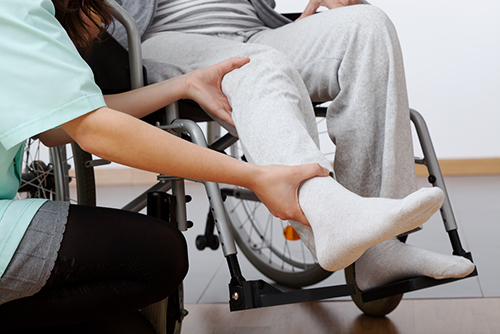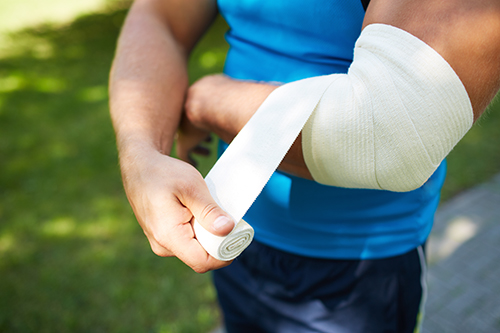
People who pursue personal injury lawsuits for the first time often find the process overwhelming. Becoming familiar with the 8 steps of a personal injury lawsuit can help make the process less stressful. A clear plan of action will give you a better perspective of what to do following a personal injury. Before you start, you need to get treatment for your injury. Even if you don’t think your injury is serious, symptoms may take some time to become noticeable. Make sure you get the medical treatment you need immediately after the accident.

Car accidents are the most common cause of personal injury claims. Other types of claims include medical malpractice, defective products, slips & falls, dog bites, and intentional acts like assault & battery. Cases differ in complexity but most follow the same basic steps. In any case, the factor that determines whether you have a valid claim is whether you can prove it was another person’s or entity’s fault. A personal injury claim is primarily based on the fact that another person caused your injury. You will also need to prove that your injuries are real and that they occurred during the accident.
8 Steps of a Personal Injury Lawsuit
-
Find the Right Attorney
You must choose a personal injury attorney before you even make the decision to file a claim. It isn’t enough to find an attorney willing to take your case. The success of the entire process depends on who you have to guide and represent you the rest of the way.
The first meeting with an attorney is an “initial consultation.” During this meeting, you will get to know the lawyer and how the firm works. Take a list of questions with you, along with any information you have related to your case. You will tell the attorney what happened and present any information that you have collected so far. For example, if you had a car accident, bring the accident report in addition to your medical treatment records.
The attorney will look at the circumstances of your case and determine if you should go forward with your claim. He is an expert in personal injury law and he knows which laws pertain to your personal situation. If you don’t feel comfortable with the attorney, you don’t have to stay with that firm. The initial consultation is a chance to gather information and make sure they are a good match for you. You will work with your attorney throughout the claim process. Get an attorney that you feel comfortable with and who takes the time to explain the details of your case with you.
If you decide to go forward with your claim, he may ask you to sign an authorization form to get your medical records. He will also ask about your insurance coverage and whether you have talked with any insurance adjusters about the case. He will want to know if you made any recorded or written statements. The attorney will also want to know about any previous interviews and, if so, what you said. If the attorney wants to take time to consider the facts of your case before proceeding, don’t worry. This isn’t unusual.\

-
Filing the Claim
Once you make the decision to file a claim, it is time to file the needed documents with the court. These initials documents, or “pleadings,” include the complaint or petition. It identifies the parties of the case and sets the legal basis for the case. The complaint also includes a section where the plaintiff explains what they want the court to require from the defendant. This is the area where you will submit the amount of compensation you want. Other documents include the summons from the court where the litigation will take place. This document is the notification to the defendant about the claim and the consequences if they fail to respond. If the defendant doesn’t “show up” in court, the case can still be decided without them and held to the result even if they failed to participate. Once you submit all the required documents, the court will serve the person you file the complaint against with a summons containing the “Notice” of the lawsuit.
It is important to note that while you aren’t required to have your claim filed by an attorney, you should. One mistake could slow down the process or result in the court denying your claim. The process of filing a personal injury claim involves multiple documents. Since you don’t have to pay any attorneys’ fees until you collect on your claim, it is always in your best interest to have legal representation.
-
Discovery & Fact Finding
Discovery refers to the process where attorneys obtain information in the form of documents such as the names of potential witnesses, depositions, examinations of the accident scene, and other information they will use during the case. Both parties exchange documents to prepare them for their defense including document production, written discovery, and depositions. The latter are sworn statements made in response to an attorney’s questions and recorded by a court reporter. You should always respond honestly to these questions and only give answers that you know for certain. The goal of discovery is to gather the facts of the case, not opinions or lies. It only takes getting caught at one lie to destroy your credibility.
Federal law requires the disclosure of all facts and documents prior to the trial. Only information deemed “privileged” is not shared. This usually includes conversations between a husband and wife, a lawyer and client, doctor and patient, or a religious advisor and advisee.
The information shared includes anything you said or did in front of witnesses. This is why you should never claim guilt or admit fault after any type of accident. The defense can misconstrue what you said and hurt your chances of winning your case later on.
-
Pre-Trial Resolution, Motions
During this step of the personal injury lawsuit, lawyers of both parties make motions to create rules for the litigation process. Sometimes these motions are about incidental questions. Other times, they bring a claim to an end before it ever goes to litigation, reducing the steps of a personal injury lawsuit to 4. “Dispositive motions” have the potential to bring litigation to an end before it begins.
-
Negotiation & Settlements
In many cases, both sides come to an agreement before the case goes to trial. It is in the best interest of the plaintiff to offer a settlement and avoid the cost and time of a court hearing. Of course, reaching a settlement is only to your advantage if it is for a fair amount. This is why you need an experienced personal injury attorney on your side.
Insurance companies rely on a number of tactics to get out of paying accident victims a settlement, or they try to pay less than they deserve. Without the knowledge to evaluate the settlement offer, they may think that this is the best deal they can get. The attorney has the skills and the knowledge to negotiate a settlement that is fair, or else to advance to court. If there is a successful negotiation, the process stops here. Otherwise, the case advances to trial.

-
Litigation
Jury selection precedes the trial unless the trial will take place in front of only a judge. Your attorney and that of the plaintiff question potential jurors and exclude those they feel lack the characteristics to be impartial. A lot of thought goes into the jury selection process. After all, these are the people who will decide the verdict of your case. This is another area where the experience and skills of your personal injury lawyer come into play.
The trial begins with opening statements and ends with closing arguments. During the trial, your personal injury attorney will argue your case. Both sides will present evidence and testimonies given, as well as cross-examine witnesses. It is the job of the attorneys on each side to argue the case for their client and to try and to discredit the other side. Each side receives equal time and opportunity to argue their case before a jury. Disproving the other side’s case is equally important to proving your own.
-
Post-Trial Collections
Once the arguments end, the jury will meet to discuss the evidence presented. Once they come to a decision, the judge will reveal the verdict. If you win your case, the court will issue an order against the plaintiff for payment.
In California, there is a possibility that you must accept part of the responsibility for the accident that caused your personal injury. If so, you can only receive the percentage of compensation for which the other party is to blame. For example, if the court finds you 20% at-fault and the other person 80% at-fault, you will only receive 80% of the total amount of damages.
There is also the possibility that you will not win your case at all. Some of the most common reasons that people lose personal injury cases include:
-
- Failing to Provide Adequate Proof – Not only do you have to prove that the other person is at least partially at fault, but the other side may deny that your injury occurred during the accident. They can also claim that it was pre-existing or not as serious as you claim. The sooner you get a personal injury lawyer to guide you through the steps of what to do after an accident, the better he will be able to prepare a solid case.
- Loss of Credibility – In spite of equal time to present your argument, the defense is there to make you appear less credible. Personal injury claims are still considered by many to be frivolous. A gap in documentation or in any of the steps of a personal injury lawsuit can leave room for the defense to cast doubt on your claims. Always get medical treatment for your injuries, including any recommended diagnostics or therapy. Go to a specialist who handles your type of injury. Take any medications and meet follow-up appointments. Failure to treat your injury with the appropriate level of seriousness could result in the loss of your case.
- Lack of Expert Testimony – Expert testimony often makes or breaks a personal injury case. In fact, it is the only way to counteract the accusations made by the defense. An expert can tell the jury what your injury is and how it impacts your life.
- Choosing the Wrong Lawyer – Personal injury is a complex area of law. Failing to hire an experienced attorney who specializes in personal injury cases will result in an ineffective presentation. Choose a personal injury attorney who has won many cases like yours.

- Appeal
At the end of the trial, either party has the option to file an appeal if they are not happy with the verdict. Unlike a trial, neither side gives testimony or presents evidence. Instead of a single judge or jury, multiple judges hear the appeal.
Even after you complete the 8 steps of a personal lawsuit and win your case, it may not be the end of the lawsuit. Some individuals or businesses refuse to pay or they simply lack the funds. Your personal injury attorney will advise you on any additional steps you need to take to collect the compensation the court awarded to you. An experienced personal injury attorney has the skills needed to help with your personal injury lawsuit every step of the way.
Batta Fulkerson is a San Diego personal injury law firm with a long record of success in auto accidents, dog bites, premise liability, and all types of personal injury cases. We have successfully negotiated millions of dollars in compensation for our clients. We care about the cases we take and the victims of personal injury left to try and put their lives back together under incredibly difficult circumstances. Contact us today and schedule your free consultation. We’re here to guide you through all the steps of a personal injury lawsuit.



